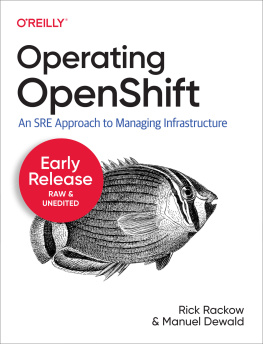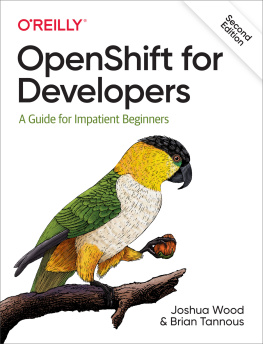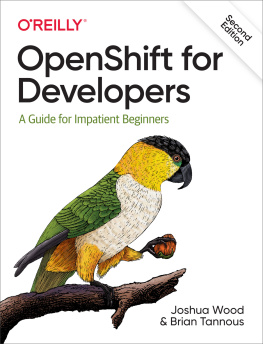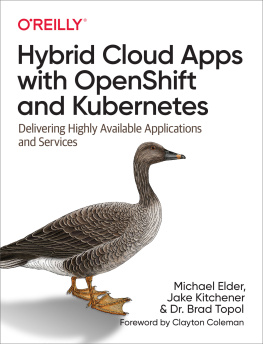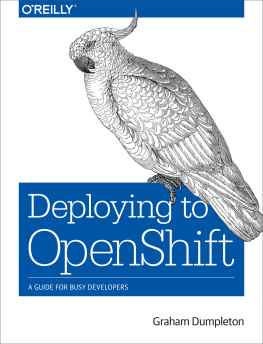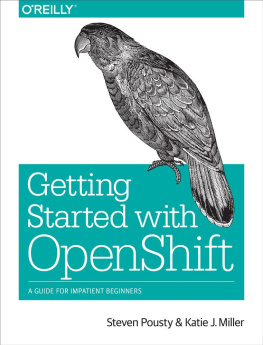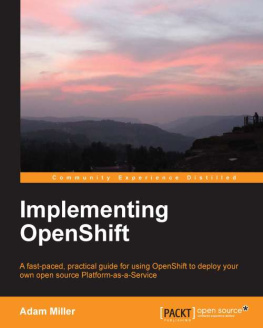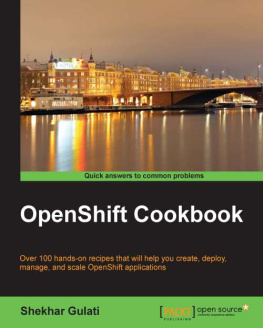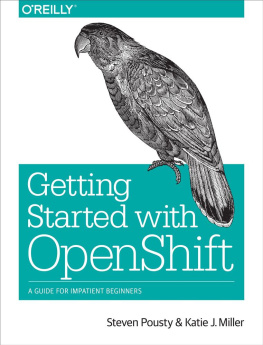Rick Rackow - Operating OpenShift
Here you can read online Rick Rackow - Operating OpenShift full text of the book (entire story) in english for free. Download pdf and epub, get meaning, cover and reviews about this ebook. year: 2022, publisher: OReilly Media, Inc., genre: Romance novel. Description of the work, (preface) as well as reviews are available. Best literature library LitArk.com created for fans of good reading and offers a wide selection of genres:
Romance novel
Science fiction
Adventure
Detective
Science
History
Home and family
Prose
Art
Politics
Computer
Non-fiction
Religion
Business
Children
Humor
Choose a favorite category and find really read worthwhile books. Enjoy immersion in the world of imagination, feel the emotions of the characters or learn something new for yourself, make an fascinating discovery.
- Book:Operating OpenShift
- Author:
- Publisher:OReilly Media, Inc.
- Genre:
- Year:2022
- Rating:5 / 5
- Favourites:Add to favourites
- Your mark:
- 100
- 1
- 2
- 3
- 4
- 5
Operating OpenShift: summary, description and annotation
We offer to read an annotation, description, summary or preface (depends on what the author of the book "Operating OpenShift" wrote himself). If you haven't found the necessary information about the book — write in the comments, we will try to find it.
Operating OpenShift — read online for free the complete book (whole text) full work
Below is the text of the book, divided by pages. System saving the place of the last page read, allows you to conveniently read the book "Operating OpenShift" online for free, without having to search again every time where you left off. Put a bookmark, and you can go to the page where you finished reading at any time.
Font size:
Interval:
Bookmark:

by Rick Rackow and Manuel Dewald
Copyright 2022 Rick Rackow and Manuel Dewald. All rights reserved.
Printed in the United States of America.
Published by OReilly Media, Inc. , 1005 Gravenstein Highway North, Sebastopol, CA 95472.
OReilly books may be purchased for educational, business, or sales promotional use. Online editions are also available for most titles (http://oreilly.com). For more information, contact our corporate/institutional sales department: 800-998-9938 or corporate@oreilly.com .
- Acquisitions Editor: John Devins
- Development Editor: Corbin Collins
- Production Editor: Clare Jensen
- Interior Designer: David Futato
- Cover Designer: Karen Montgomery
- Illustrator: Kate Dullea
- November 2022: First Edition
- 2022-05-16: First Release
See http://oreilly.com/catalog/errata.csp?isbn=9781098106393 for release details.
The OReilly logo is a registered trademark of OReilly Media, Inc. Operating OpenShift, the cover image, and related trade dress are trademarks of OReilly Media, Inc.
The views expressed in this work are those of the authors, and do not represent the publishers views. While the publisher and the authors have used good faith efforts to ensure that the information and instructions contained in this work are accurate, the publisher and the authors disclaim all responsibility for errors or omissions, including without limitation responsibility for damages resulting from the use of or reliance on this work. Use of the information and instructions contained in this work is at your own risk. If any code samples or other technology this work contains or describes is subject to open source licenses or the intellectual property rights of others, it is your responsibility to ensure that your use thereof complies with such licenses and/or rights.
978-1-098-10632-4
With Early Release ebooks, you get books in their earliest formthe authors raw and unedited content as they writeso you can take advantage of these technologies long before the official release of these titles.
This will be the 1st chapter of the final book. Please note that the GitHub repo will be made active later on.
If you have comments about how we might improve the content and/or examples in this book, or if you notice missing material within this chapter, please reach out to the development editor at .
Operating distributed software is a difficult task.This task requires humans with a deep understanding of the system they maintain.No matter how much automation you create, it will never replace highly skilled operations personnel.
OpenShift is a platform, built to help software teams develop and deploy their distributed software.It comes with a large set of tools that are built-in or can be deployed easily.While it can be of great help to its users and eliminate a lot of traditionally manual operations burdens, OpenShift itself is a distributed system as well, that needs to be deployed, operated, and maintained.
Many companies have platform teams that provide development platforms based on OpenShift to software teams so the maintenance effort is centralized and the deployment patterns are standardized across organizations.These platform teams shift more and more into the direction of Site Reliability Engineering (SRE) teams, where software development practices are applied to operations tasks.Scripts are replaced by proper software solutions that can be tested easier and deployed automatically using CI/CD systems.Alerts are turned from simple cause-based alerts like a high amount of memory is used on Virtual Machine 23 into symptom-based alerts based on Service Level Objectives (SLO) that reflect customer experience, like processing of requests takes longer than we expect it to.
OpenShift provides all the tools you need to run software on top of it with SRE paradigms, from a monitoring stack to an integrated CI/CD system that you can use to observe and run both the software deployed to the OpenShift cluster, as well as the cluster itself.But still building the automation, implementing a good alerting strategy, and finally debugging issues that occur when operating an OpenShift cluster is a difficult task that requires skilled operations or SRE staffing.
Even in SRE teams, traditionally a good portion of the engineers time is dedicated to manual operations tasks, often called toil.The operations time should be capped, though, as the main goal of SRE is to tackle the toil with software engineering.In Site Reliability Engineering, the authors suggest a 50% cap for working on toil.
The goal of having an upper limit for toil is to avoid shifting back into an operations team where people spend most of the time working down toil that accumulates with both the scale of service adoption and the advancement of the software.
A part of the accumulating toil while the service adoption grows is the number of alerts an operations team gets if the alerting strategy isnt ready for scaling.If youre maintaining software that creates one alert per day per tenant, keeping one engineer busy running 10 tenants, you will need to scale the number of on-call engineers linearly with the number of tenants the team operates.That means in order to double the number of tenants, you need to double the number of engineers dedicated to reacting to alerts.These engineers will effectively not be able to work on reducing the toil created by the alerts while working down the toil and investigating the issues.
In a traditional operations team that runs OpenShift as a development platform for other organizations of the company, onboarding new tenants often is a manual task.It may be initiated by the requesting team to open a ticket that asks for a new OpenShift cluster.Someone from the operations team will pick up the ticket and start creating the requirements, kick off the installer, configure the cluster so the requesting team gets access, etc.A similar process may be set up for turning down clusters when they are not needed anymore.Managing the lifecycle of OpenShift clusters can be a huge source of toil, and as you can see it will naturally scale with the adoption of the service.
In addition to being a toil-packed process, manual lifecycle and configuration management are error-prone.When an engineer runs the same procedure several times during the week, as documented in a team-managed Wiki, chances are they miss an important step or pass a wrong parameter to any of the scripts, resulting in a broken state that may not be discovered immediately.
When managing multiple OpenShift clusters, having one that is slightly different from the others due to a mistake in the provisioning or configuration process, or even due to a customer request is dangerous and usually generates more toil.Automation that the team generated over time may not be tailored to the specifics of a single snowflake cluster.Running that automation may just not be possible, causing more toil for the operations team.In the worst case, it may even render the cluster unusable.
Automation in a traditional ops team can often be found in a central repository, that can be checked out on engineer devices so they can run the scripts they need as part of working on a documented process.This is problematic not only because it still needs manual interaction and hence doesnt scale well, but also do engineer devices often be configured differently.They can differ in the OS they use, adding the need to support different vendors in the tooling, e.g. by providing a standardized environment like a container environment to run the automation.
Font size:
Interval:
Bookmark:
Similar books «Operating OpenShift»
Look at similar books to Operating OpenShift. We have selected literature similar in name and meaning in the hope of providing readers with more options to find new, interesting, not yet read works.
Discussion, reviews of the book Operating OpenShift and just readers' own opinions. Leave your comments, write what you think about the work, its meaning or the main characters. Specify what exactly you liked and what you didn't like, and why you think so.

